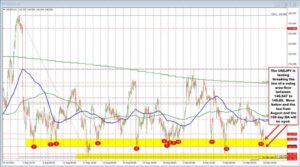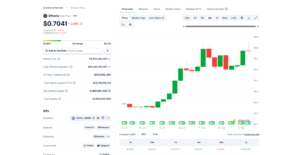Best Pharmaceutical Stocks to Invest in 2025: Top Drug Stocks Analysis

Pharmaceutical stocks are considered high-risk assets. Their performance depends on fundamental factors such as the success of new medicines, the outcomes of pre-launch trials, and competition from both licensed drugs and generics. Although the biotechnology sector may lag behind other industries like technology in the long term, healthcare stocks can deliver impressive short-term returns, often exceeding 50–100% within just a few months.
This overview explains how to develop strategies for investing in pharmaceutical shares, highlighting the key factors that drive share prices, the best times to buy or sell, and the companies with the strongest growth potential and attractive dividends in the global pharmaceutical industry.
The article covers the following subjects:
Major Takeaways
- Pharmaceutical stocks are highly volatile assets that are more suitable for trading based on fundamental analysis and short- or medium-term (up to one year) investment.
- The world’s largest pharmaceutical companies include Eli Lilly (LLY), Johnson & Johnson (JNJ), AbbVie (ABBV), Roche (ROG.SW), and AstraZeneca (AZN).
- The best dividend stocks highlighted by analysts and analyst rating reports are Pfizer Inc. (PFE), Amgen Inc. (AMGN), and AbbVie Inc. (ABBV).
- Growth factors include the introduction of new drugs or modifications to existing products, factors influencing demand, like epidemics or pandemics, and technologies that reduce the cost of medicines in demand.
- Risk factors are failed clinical trials, litigation and regulatory restrictions, and competition from generic drugs.
Why and How to Invest in Pharma Stocks
Companies in the pharmaceutical, biotechnology, and healthcare sectors cover the following areas:
- research and development of pharmaceuticals;
- conducting preclinical studies and clinical trials;
- biotechnology research and genetic technologies;
- engineering and production of medical devices and equipment;
- diagnostic services.
Any technological breakthrough in these fields enhances the quality of life. Everyone strives to stay healthy and feel their best for as long as possible. This is why demand in the pharmaceutical and biotechnology markets will always be consistently strong.
Market Growth Drivers
Key growth drivers for pharma stocks:
- Positive clinical trial results for a drug that outperforms current therapies.
- Mergers and acquisitions. Buying a small company lets a corporation add a popular drug to its portfolio.
- Entering new markets.
- Cost optimization. Introduction of technologies that reduce the cost of a popular drug.
- Regulatory support limiting competition from the generic industry.
- Government contracts, such as supplying medicines to public hospitals.
- Epidemiological factors like sudden spikes in incidence, epidemics, or pandemics.
- Overall stock market growth.
Changes in financial indicators remain a key factor. Growth in revenue and net profit, along with lower debt and stronger sales, are crucial catalysts.
Defensive Investment Characteristics
Pharmaceutical and biotech stocks are not considered defensive assets. Instead, they are highly risky instruments with strong volatility.
The chart above shows the price movement of Johnson & Johnson (JNJ), the world’s second-largest pharmaceutical company by market capitalization. While its 5-year return was only 14.8%, market participants had the chance to earn 12–15% in just three months by trading on the price fluctuations in both directions. Although J&J is not the most reliable defensive asset, it can be well-suited for short- and medium-term stock trading. For long-term investments, it is better to focus on blue-chip stocks.
Dividend Income Potential
The dividend potential of pharmaceutical and biotechnology companies is limited. These companies typically pay dividends only when they earn profits. In this regard, pharmaceutical companies often fall short compared to other sectors of the economy, largely due to their inconsistent financial performance.
According to the NYU Stern School of Business, the average annual dividend yield of biotech companies stood at 2.3% as of January 1, 2025, compared with 1.6% for pharmaceutical stocks. Some companies, such as Pfizer Inc., offer yields above 3–4% per annum, though such cases remain the exception.
The chemicals, oil & gas, and consumer goods sectors are considered attractive not only for high dividend yields but also for their steady share price growth.
Top Best Pharmaceutical Stocks to Buy Now
The healthcare sector can be highly volatile and sometimes unpredictable. Although top global pharmaceutical stocks may offer short-term gains, they can be unprofitable in the long term. Instead of focusing on market cap or scale, look at 1-year and 5-year returns. In this respect, small- and mid-cap companies may prove to be much more attractive.
The best pharma stocks to invest in:
Verona Pharma PLC (VRNA)
Verona Pharma is a biopharmaceutical company focused on inhaled therapies for chronic respiratory diseases. In July 2025, the company was acquired by Merck & Co., one of the top 10 pharmaceutical companies. Nevertheless, Verona’s shares continue to trade on the stock exchanges.
Kuros Biosciences AG (KURN)
Kuros Biosciences AG is a Swiss biopharmaceutical company specializing in research and development in regenerative medicine. It focuses on creating medication for the treatment of bone and soft tissue.
Corcept Therapeutics Inc (CORT)
Corcept Therapeutics Inc. is a US-based biopharmaceutical company engaged in the discovery and development of cortisol-modulating therapies for serious endocrinologic, oncologic, metabolic, and neurologic diseases.
Corcept develops treatments for patients with metabolic conditions, various cancers, mental disorders, and metabolic diseases such as diabetes or glucose intolerance, particularly for those who are not candidates for surgery.
Liquidia Corporation (LQDA)
Liquidia is a biopharmaceutical company focused on developing and commercializing drugs for rare cardiopulmonary diseases and pulmonary arterial hypertension. The company was founded in 2004 and has approximately 170 employees. Its customers include cardiopulmonary centres and patients with severe pulmonary haemodynamic disorders.
Eli Lilly & Company (LLY)
Eli Lilly & Company is an American pharmaceutical company specializing in innovative small-molecule drugs, peptide-based therapies, and biologics in areas such as metabolic disorders, oncology, immunology, and neurology. Notably, the company was the first to mass-produce insulin commercially. Additionally, Eli Lilly is included in the S&P 500 index.
The company is among the leading developers of GLP-1 and GIP receptor agonists for the treatment of type 2 diabetes, obesity, with approved indications such as rheumatoid arthritis and ulcerative colitis. It also advances antibody and inhibitor medicines targeting cancer and immune-related diseases, often seeking additional approvals and new formulations.
Key Financial Metrics for Evaluating Drug Stocks
Criteria for evaluating drug stocks:
- Financial statements. Changes in valuation multiples relative to historical periods and sector averages.
- Product pipeline. Timely completion of all clinical trial phases and assessment of approval chances by the FDA or EMA.
- Market potential of the product line.
- Regulatory and legal risks.
- Partners, alliances with major pharmaceutical companies.
- Patent expiry. Once a patent expires, competitors are free to introduce generic alternatives.
- Strong brand reputation among doctors, patients, and government agencies, and no past litigation record.
Technical analysis may also be used, though fundamental factors have a stronger influence.
Drug Development Pipeline Analysis
A development pipeline is a company’s portfolio of drug candidates at different preclinical and clinical stages. It serves as a roadmap, indicating where each drug stands in its development.
Key development pipeline metrics:
- Total number of drug candidates in development. A larger pipeline often increases the likelihood of commercial success.
- Focus on high-margin therapeutic areas, such as oncology, rare diseases, and biotechnology projects.
- Partnerships and licensing agreements signal confidence from external investors.
- Probability of success (PoS) at each clinical trial phase helps to assess the likelihood of a drug being approved. There are four phases in clinical trials: safety and dosage testing, efficacy and side effects, large-scale trials, and post-marketing surveillance.
It may take 10 years or more between the first and fourth phases. Moreover, there is a risk that problems may arise with the drug at any stage.
Profitability and Revenue Growth Indicators
These metrics help to understand how effectively a business generates profit and how sustainable its growth is:
- Revenue growth is the change in sales compared with previous periods.
- Gross margin is the percentage of revenue remaining after deducting the cost of goods sold. A margin of 60–80% indicates strong pricing power and protection from competition.
- Operating margin measures profit from core operations before interest and taxes (EBIT). It is calculated as operating income divided by revenue.
- Net profit margin shows the share of net income relative to total revenue and is calculated as net income divided by revenue.
Valuation multiples are usually reported in a company’s financial statements or on financial analysis websites.
Dividend Sustainability Assessment
Dividend stability is essential for those who are focused on long-term investing and regular dividend payouts. Pharmaceutical stocks tend to reinvest their net profits in research and development, which is why their average annual dividend yield is relatively low.
Besides, pharmaceutical stocks often show uneven net profit growth. For instance, British-Swedish giant AstraZeneca has reported significant fluctuations in quarterly earnings over the past three years, even posting losses in some quarters in 2021.
Best Performing Pharmaceutical Stocks by Category
The key problem with healthcare stocks is their high volatility and, accordingly, the lack of stable revenue/net profit growth. Most of the top 20 companies by market capitalization exhibit either a downtrend or up to 10% annual returns over a 1-year and 5-year period.
Tip: Focus on stocks with a stable long-term uptrend or profit from short- and medium-term volatility.
Highest Dividend Yield Pharma Stocks
CompaniesMarketCap presents the following list of companies with the highest dividend yields:
However, the ranking reflects dividend yields alone and does not take into account how the share prices of healthcare companies have changed over time. For example, Organon shares have fallen by more than 70% over five years, and Nykode Therapeutics shares have dropped by more than 92%. Below is a list of alternative companies that not only pay high dividends but also have great growth potential.
Pharmaceutical stocks with high dividends and stable payouts:
Fastest Growing Drug Companies
In the healthcare sector, strong gains today do not guarantee further upside tomorrow. Sharp rallies in biotech stocks are usually driven by favorable clinical trial results or the launch of a new drug, but such moves tend to be one-off rather than permanent.
Bright Minds Biosciences (DRUG) is a clear example of a biotech company that exhibits this type of price action:
Healthcare sector stocks with the highest returns over the past year (as of July 28, 2025):
Most Undervalued Pharmaceutical Stocks
The degree of undervaluation is typically assessed through the following valuation multiples:
- P/B < 1.
- P/E ratio below industry average.
- High ROA and ROI values with low EBITDA.
You can also look at the chart: if the price moves away from its historical high but then tries to return to it, there are signs of undervaluation.
Examples of undervalued healthcare stocks with long-term growth potential:
|
Company |
1-Year Return, % |
5-Year Return, % |
Price/Fair Value |
|
|
1 |
Intellia Therapeutics (NTLA) |
-54.34 |
-35.84 |
0.2 |
|
2 |
Novo Nordisk (NVO) |
-66.16 |
48.69 |
0.35 |
|
3 |
Merck & Co. (MRK) |
-31.25 |
2.27 |
0.73 |
|
4 |
Amgen (AMGN) |
-12.72 |
19.70 |
0.82 |
|
5 |
GSK (GSK) |
-8.52 |
-9.66 |
0.92 |
Investment Risks and How to Mitigate Them
Potential risks of investing in pharmaceutical stocks:
- Regulatory risk. Rejection of a drug by the FDA, EMA, or other regulatory authorities.
- Clinical trial failure. Setbacks in Phase II or Phase III trials can greatly reduce the likelihood of commercializing a drug.
- Patent risk. The expiry of a patent opens up the pharmaceutical market to generic competitors, often eroding the original manufacturer’s revenue and market share.
- Government regulation. Regulators may limit price increases for drugs in order to prevent pharmaceutical companies from making excessive profits.
- Patient complaints and class action lawsuits.
Furthermore, it is crucial to consider the traditional risks common to any company, such as geopolitical risks, trade wars, and successful developments by competitors.
Patent Cliff Risks
Patent rules vary by country. In the US, pharmaceutical patents generally last up to 20 years from the filing date. However, because much of that time is consumed by clinical trials and the FDA approval process, the effective market exclusivity period is often only 7–14 years.
The more time a pharmaceutical company spends on research and clinical testing, the shorter its effective patent life once the drug reaches the market. After the patent expires, generic manufacturers are free to produce identical versions without infringing the original company’s patent rights.
Regulatory and FDA Approval Challenges
Regulatory risks include:
- Possible rejection of a drug by regulators or the imposition of additional restrictions, such as requirements for further clinical trials or the disclosure of unsatisfactory trial results.
- Existing or potential legal claims, for instance, if side effects emerge that were not detected in testing or listed on the drug label.
- Changes in local healthcare legislation.
The primary regulatory body for the pharmaceutical industry in the US is the Food and Drug Administration (FDA).
Competition from Generic Drugs
Generics are drugs that contain the same active ingredient as the original product, but they are introduced only after the original patent has expired. In some cases, manufacturers make minor modifications to the original drug and market it under a different name, often without repeating full clinical trials.
Before launching a drug into mass production, large pharmaceutical companies undergo dozens of tests to obtain patents and regulatory approvals. However, once the drug enters the international pharmaceutical market, regional companies copy the successful product and set a lower price. Buyers in local markets are willing to take health risks in favour of cheaper analogues, which means that the original drug manufacturer loses profits.
Conclusion
Let’s sum up the article:
- Long-term investments in pharmaceutical and biotechnology stocks are high-risk and not always justified. For instance, Pfizer and Moderna, leaders in the vaccine market during the pandemic, have posted losses over the past five years. By contrast, only AstraZeneca has delivered a gain, with its stock up about 30% over the same period, equivalent to roughly 6% annually, making it one of the largest companies that analysts often cite in drug stock investment reviews.
- When it comes to dividend yield, the pharmaceutical sector is less consistent in both payout amounts and timing than many others.
- Healthcare stocks can be appealing for short-term investing, as catalysts like new drug launches or positive clinical trial results sometimes drive rapid gains of 50% or more within weeks. Yet those very factors can just as quickly send share prices sharply lower.
Healthcare stocks are more suitable for professional traders who are prepared to take risks and know how to use volatility to their advantage. That said, the stock market as a whole carries inherent risk, so long-term investors may prefer to include only a limited number of biotech stocks in their diversified investment portfolios.
Pharmaceutical Stocks FAQs
The content of this article reflects the author’s opinion and does not necessarily reflect the official position of LiteFinance broker. The material published on this page is provided for informational purposes only and should not be considered as the provision of investment advice for the purposes of Directive 2014/65/EU.
According to copyright law, this article is considered intellectual property, which includes a prohibition on copying and distributing it without consent.






